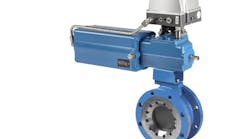ATEX DIRECTIVE: All equipment intended for use in explosive atmospheres must comply with the ATEX Directive in order to be sold into the European Union.
CONTROL LOOP: An arrangement of physical and electronic components for process control. The electronic components of the loop continuously measure one or more aspects of the process, then alter those aspects as necessary to achieve a desired process condition.
EXPLOSION-PROOF: A type of protection that utilizes an enclosure that is capable of withstanding an explosive gas or vapor within it and/or preventing the ignition of an explosive gas or vapor that may surround it.
HART: The HART (Highway Addressable Remote Transducer) protocol gives field devices the capability of communicating instrument and process data digitally. This digital communication occurs over the same two-wire loop that provides the 4-20 mA process control signal without disrupting the process signal.
HART FILTER: The HART filter is a passive device that is inserted in field wiring from the HART loop. Its purpose is to effectively isolate the control system output from modulated HART communication signals and raise the impedance of the control system to allow HART communication.
HOT SWAP: The Hot Swap procedure allows you to input the configuration of one digital valve controller into another digital valve controller of the same type. This procedure can be used when a situation occurs that requires the partial or complete replacement of a digital valve controller.
FIELDBUS: FOUNDATION fieldbus communication is an all-digital, serial, two-way communication system, which interconnects field equipment such as transmitters, digital valve controllers, and process controllers.
FUNCTION BLOCK: Function blocks perform process control functions, such as analog input (AI) and analog output (AO), as well as proportional-integral-derivative (PID) functions. The standard function blocks provide a common structure for defining function block inputs, outputs, control parameters, events, alarms, and modes, and combining them into a process that can be implemented within a single device or over the fieldbus network. This simplifies the identification of characteristics that are common to function blocks.
NVM: Non-Volatile Memory (NVM) is a type of semiconductor memory that retains its contents even though power is disconnected. NVM contents can be changed during configuration, unlike ROM, which can be changed only at the time of instrument manufacture.
PRESSURE SENSOR: An instrument internal device that senses pneumatic pressure. Some digital valve controllers have three pressure sensors – one to sense supply pressure and two to sense the output pressures.
RESOURCE BLOCK: Contains the hardware-specific characteristics associated with a fieldbus device; it has no input or output parameters. The resource block monitors and controls the general operation of other blocks within the device.
SIS: Safety Instrument Systems (SIS) are specifically designed to reduce the likelihood or the severity of the impact of an identified event, thus helping to protect personnel, equipment, and the environment. These systems involve final control elements, which are, for the most part, held in one position and requested to move only when an emergency situation arises.
SOFTWARE: Microprocessor or computer programs and routines that reside in alterable memory (usually RAM), as opposed to firmware, which consists of programs and routines that are programmed into memory (usually ROM) when the instrument is manufactured. Software can be manipulated during normal operation, firmware cannot.
TRANSDUCER BLOCK: Transducer blocks connect function blocks to local input/output functions. They read sensor hardware and write to effector (actuator) hardware.
TYPE n: A type of protection applied to electrical equipment so that in normal operation it is not capable of igniting a surrounding explosive atmosphere. This type of protection is referred to as “Ex n”.
The terms and definitions for this glossary were contributed by Emerson Process Management, Fisher, a manufacturer of control valves, regulators, instrumentation and performance services for the process control industry.

